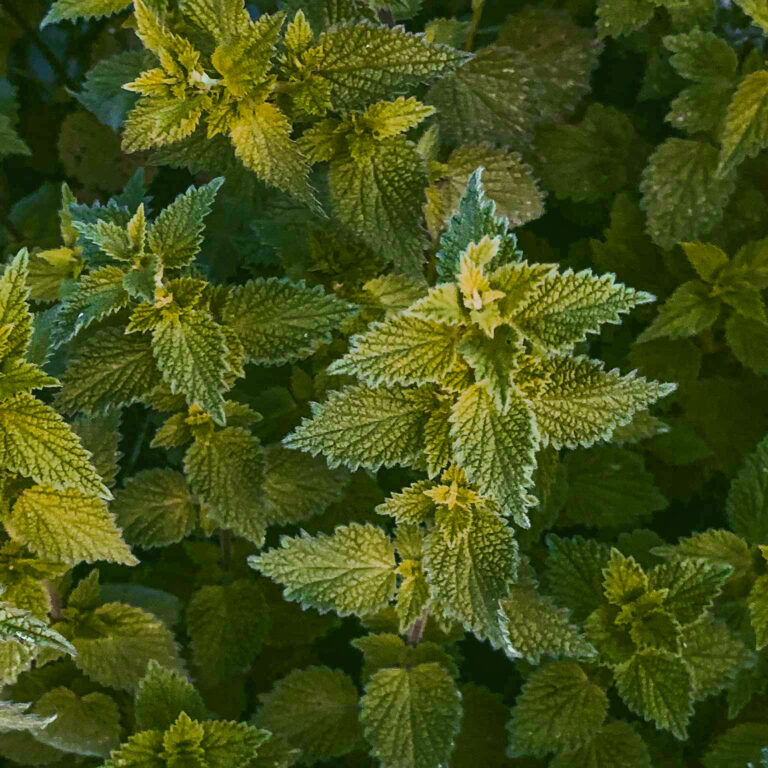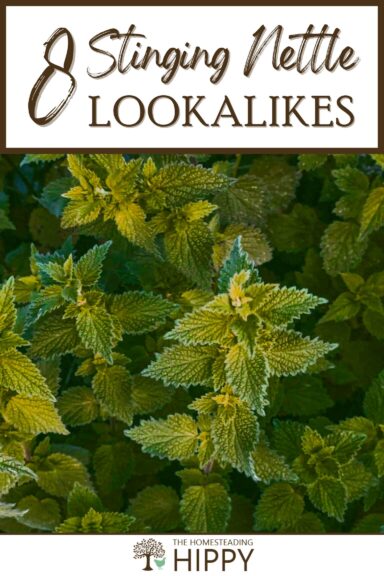Stinging nettle is a plant that is loved or hated depending on who you talk to. Some folks love the plant for its excellent nutritional value while others despise it as an annoying and intrusive weed.

Whether you love it or hate it, no one likes its tendency to inflict a painful, lingering, burning sting, hence the name!
One bad encounter with this troublesome plant is enough to make you wary ever after.
But, you might be afraid for nothing because it turns out that stinging nettle has many look-alikes, some of which are harmless and some are even helpful.
I’ll tell you about eight such plants below, and how to recognize them in the field…
1. Spearmint (Mentha spicata)
Spearmint, Mentha spicata, is a beloved herb used for its bracing, minty flavor, but it is also an herb easily confused for stinging nettle.
Spearmint is a perennial herb that can reach 1 to 3 ½ feet in height. Its stems and foliage can be smooth or, much like the stinging nettle, covered in fine, fuzzy hairs.
However, spearmint leaves are on average two inches long, bright green, oblong or lance-shaped, veined, and wrinkly or unevenly toothed.
Also like stinging nettle, it thrives in moist fields as well as pond or lake margins.
If you’re unsure about spearmint, know it prefers full-sun locations, but it can also thrive in partial shade in ideal conditions: well-draining, rich, and moist soils will easily grow spearmint.
But totally unlike stinging nettle, spearmint is safe to touch. As mentioned, the leaves are used fresh or dried to flavor to all kinds of foods or bring a pleasant aroma to a room when picked fresh.
2. Northern Bugleweed (Lycopus uniflorus)
Northern Bugleweed, scientifically known as Lycopus uniflorus, is another plant that you might easily mistake for the stinging nettle.
This is a perennial herb, one native to North America that’s commonly found growing in wet areas such as marshes and along the edges of ponds or lakes.
Bugleweed stands about 1 to 3 feet tall, and has densely hairy stem much like the stinging nettle.
But unlike the stinging nettle (and relatives), its leaves are smooth, lance-shaped, and have “blunt” or rounded teeth on the edges.
The leaves grow in pairs opposite each other along the stem, which might also lead you to mistake it for a stinging nettle if you’re not careful.
And, thankfully, Northern Bugleweed is safe to touch. In fact, it has long been used for medicinal purposes by Native Americans thanks to its purported sedative properties.
Historical records show it was also used by the Natives to alleviate anxiety. But do take care if you decide to forage some: despite its historical use, modern science has yet to fully endorse or confirm the benefits of Northern Bugleweed!
3. White Snakeroot (Eupatorium rugosum)
White Snakeroot typically grows to be anywhere from 1 ½ to 4 feet tall, with smooth, hairless stems that branch occasionally.
The leaves are vaguely heart-shaped, toothed, and drape elegantly from the stems.
In the late summer or fall it blooms with splashes of small white flowers at the top of its stems.
White Snakeroot can also easily be confused for stinging nettle, and grows in many of the same places as nettle: native to North America, it thrives beneath the canopy of forests, especially in moist and shady areas.
But while it might be mistaken for nettle, you should avoid a potential confirmation in any case: while it might look harmless, White Snakeroot is actually quite poisonous.
It has a toxin called tremetol which, if ingested by livestock, can cause sickness and taint milk in dairy animals.
Aside from inflicting a potentially fatal disease, it can also hurt or kill people who consume the subsequently tainted milk!
So, while it’s generally safe to touch, make sure you don’t mistake it for an edible plant and take pains to eradicate it from grazing areas.
Most notably, this is the plant that was responsible for the death of President Abraham Lincoln’s mother.
And despite its toxicity, some fanciers consider it a beautiful and delicate addition to native plant gardens due to its very attractive flowers…
4. Clearweed (Pilea pumila)
Clearweed, Pilea pumila, is another plant that folks confuse with stinging nettle because of its highly similar foliage.
An annual herbaceous plant this time, it is native to North America and grows readily in damp, fertile soil anywhere where there’s shade such as forests, riverbanks, and wetlands.
Clearweed, which gets its name from its clear, translucent stems, stands between 1 and 2 feet tall with green, slightly translucent, and often shiny stems.
Its leaves are opposite, ovate, and have coarsely serrated margins, very much like the stinging nettle.
However, unlike the nettle, the leaves and stem are smooth to the touch; no damnable stinging hairs here!
It’s not known to be overtly harmful to humans or animals, so rest assured that clearweed is safe to touch and won’t cause any burns- assuming, of course, that you have positively ID’d it!
5. Dwarf Nettle (Urtica urens)
Imagine it: you’re out on a nature walk and you spot a plant that looks eerily similar to the stinging nettle. Almost identical, in fact. A small, erect herb is commonly found where you’d normally expect to find nettle.
It has square-ish stems adorned with fine hairs. The leaves are opposite, with an oblong- or elliptical-shape.
But it is too small to be conventional stinging nettle. Probably just another imposter right? Right? Well, touch it and find out…
Or don’t, on second thought! What you’ve actually found is Dwarf Nettle, also known as Urtica urens.
Originating from Mediterranean Europe, this smaller cousin can grow anywhere between a few inches to a little short of 2 feet in height.
But don’t be fooled by its diminutive stature: Like its larger cousin, the Dwarf Nettle also has stinging hairs that can cause burns if touched.
Touch with your eyes only; it’s best not to do it any other way!
But if you’re feeling adventurous and know what you’re doing, like its larger cousin, the Dwarf Nettle has been used traditionally as food thanks to its excellent profile of vitamins, minerals and macronutrients.
6. White Dead Nettle (Lamium album)
Despite its common name, White Dead Nettle or Lamium album, is not a true nettle and doesn’t sting. Whew!
With that out of the way, you should know that it’s a member of the mint family but shares the characteristic square stem and opposite leaf arrangement with true nettles.
An easy distinguishing feature of the White Dead Nettle is its beautiful white flowers, which bloom from spring and into late fall.
The leaves are heart-shaped, toothed, and have a similar appearance to those of the stinging nettle, which can cause some confusion to the uninitiated, though.
But what’s really fascinating about the White Dead Nettle is that is so closely mimics the stinging nettle, despite being harmless, that it is a kind of passive defense against herbivores.
It’s a case of what scientists call aggressive mimicry. And, as expected, the White Dead Nettle is not only safe to touch but is also eaten as a wild edible in survival situations and historically by frontiersmen and natives.
So next time you see it, feel free to get a closer look without any fear of stings- but be sure you have ID’ed the right plant! A mistake might be painful!
7. False Nettle (Boehmeria cylindrica)
Anywhere you go in North America, you might stumble upon a plant known as False Nettle, or Boehmeria cylindrica.
False Nettle may look quite similar to Stinging Nettle (or Wood Nettle, for that matter) due to its similarly green, heart-shaped leaves, but it completely lacks the stinging hairs that give true nettles their hated reputation.
Close but cautious inspection will reveal the difference to a sharp eye.
False Nettle often grows around 2-3 feet tall and is commonly found in moist or shady ground, riparian forests, and swamps, branching occasionally and bearing tiny, pale green flowers in small, clumped head-like clusters.
False Nettle is as mentioned safe to the touch, and it is also a surprisingly important part of the ecosystem, serving as the host plant for several species of butterflies, including Red Admiral, Question Mark, and Comma butterflies.
This makes a stand of the plant a regular subject for butterfly chasers. Next time you see this plant, feel free to get a closer look see if you can spot some of these caterpillars…
8. Horehound (Marrubium vulgare)
This perennial is native to Europe, Northern Africa, and central Asia, but has since been naturalized all over North America and elsewhere in the world.
Horehound, or Marrubium vulgare, grows up to 18 inches tall and has a blocky stem covered in thick, wooly hairs, the characteristic which most often leads to it being mistaken for stinging nettle.
Its wrinkled leaves are round to oval, deeply veined, and have a grayish-green color, which can cause further confusion between it and stinging nettle.
The easiest way to tell it apart is the thickness and quality of the hairs and its flowers: It blooms from May to September with small, white flowers forming dense spirals on the upper part of the main stem.
But here’s the good news: Horehound is safe to touch. In fact, it’s often used in herbal cough drops and candies, and even foods and beverages.
Despite or perhaps because of its bitter taste, Horehound was once used to flavor beers before hops became the de facto standard.

Tim is a farm boy with vast experience on homesteads, and with survival and prepping. He lives a self-reliant lifestyle along with his aging mother in a quiet and very conservative little town in Ohio. He teaches folks about security, prepping and self-sufficiency not just through his witty writing, but also in person.
Find out more about Tim and the rest of the crew here.
